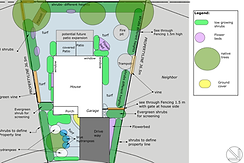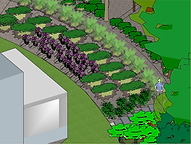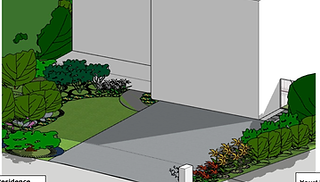
Why Create an Ecosystem
...rather than planting an arrangement of ornamentals?
"...we humans have disrupted natural habitats in so many ways and in so many places that the future of our nation's biodiversity is dim unless we start to share the places in which we live- our cities and, to an even greater extent, our suburbs- with the plants and animals that evolved there. Because life is fueled by the energy captured from the sun by plants, it will be the plants that we use in our gardens that determine what nature will be like 10, 20, and 50 years from now. If we continue to landscape predominantly with alien plants that are toxic to insects - the most important herbivores in our suburban ecosystem in terms of passing energy from plants to other animals - we may witness extinction on a scale that exceeds what occurred when a meteor struck the Yucatan peninsula at the end of the Cretaceous period. If instead we use plants that evolved with our local animal communities as the foundation of our landscapes, we may be able to save much of our biodiversity from extinction. In essence, we will for the first time coexist with nature rather than compete with her."
Douglas W. Tallamy in "Bringing nature home"
Pillars of an Ecosystem

Layers
Canopy layer - Understory layer- Shrub layer - Herbaceous layer and Ground layer are the five basic layers an ecosystem needs....birds, for example, can be found using every one of these layers within the landscape.
Native Plant selection
Insect herbivores are highly specialized eaters - exotic plants are toxic to them, they need native plants to feed on and then, in turn become food for other species. The plants we grow in our garden, directly or indirectly, sustain all of the animals we share our living spaces with.
Organic Gardening
...means a lot of different things, such as: no pesticides, no herbicides or fertilizers, less maintenance, adding organic matter to improve soil, improve soil's water retention, less interference in general.
Soil
Healthy soil is the cornerstone of a sustainable garden. Added organic matter supports the organisms in the soil and thus provides the necessary nutrients for the plants. The plants' health (or lack of) is a reflection of the soil they are growing in. Mother Nature provides us with the most nutritious mulch available: leaves - using them, instead of raking them out of the garden, not only safes money but it will ensure a sustainable soil.
Biodiversity
An Ecosystem's function and stability increases with an increase in the number of different species occupying that Ecosystem - the more different indigenous plants you have in a garden, the more different species of insects are supported, which support different species of insectivores and several different species of top predators - the interactive role of species maintains the ecosystem's function.
YourLivingLandscape SERVICES:
DESIGN process
-
Initial meeting- we discuss your vision, any issues you are experiencing with your backyard or any potential problems that I see. I take measurements as needed to create a Site plan.
-
Functional Diagrams: from the Objectives formulated after our initial meeting I create functional diagrams so we can agree on the basics - WHAT goes WHERE.
-
Concept Plan: now we are getting more specific - how many trees, bushes, perennials, how tall, wide, ...
-
Planting Plan: this is when we decide on the actual plants
-
Views: As I am using a 3D drawing tool, the design package will also include different views so you can better envision how your backyard will look like when everything is planted.
-
Maintenance Plan: Organic gardening requires less interference compared to non-organic practices. The one thing you have to add on a regular basis is organic matter to keep the soil healthy. The Maintenance plan shows you different ways of doing that.
! Services do not include Installation or Maintenance!
Cost for Design: $50.00/hour





PLANT SOURCING & DELIVERY
I will provide you with a Plantlist that includes Sources, so if you want, you can get the plants yourself.
Or, I can help you with that:
As a business I benefit from Wholesale prices at Nurseries, which I am passing on to you. I will pick up and deliver the plants to your backyard. I charge $50.00/hour.
Contact me to schedule an initial meeting
Contact Info
Johanna Stoiser
Phone
864-901-2168




